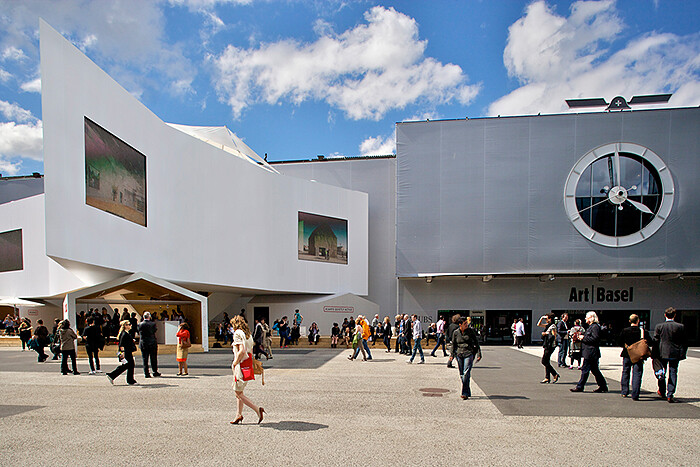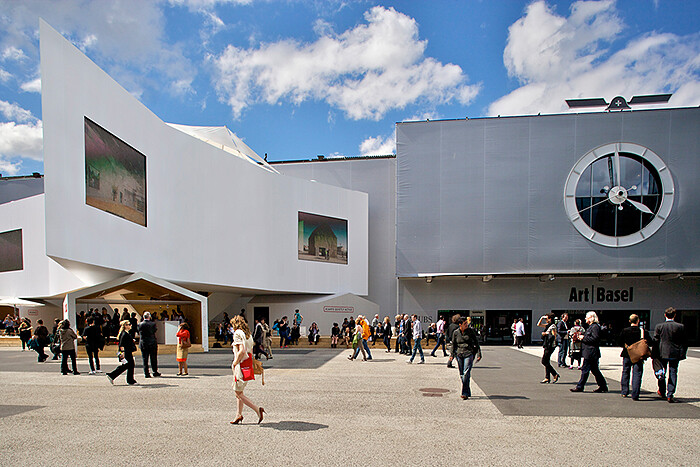Upon entering Art Basel straight off the train from Kassel, I cannot but help recall the last time Documenta coincided with Art Basel. Back in 2007 the art market, animated by the roaring finance sector, had almost superhero-like qualities, with special powers like selling work before it even existed, and adding zeros to the end of prices. Projects in Art Unlimited then were positively bombastic, like the Christoph Büchel piece Unplugged (Simply Botiful) 2006/07 that could have filled a medium-sized museum. This sensory assault was contrasted by the curatorially austere Documenta XII and Skulptur Projekte Münster that opened after Basel in quick succession. Five years on, the art world is quite a different place. Art cannot escape its relative context, and the context of the market is possibly the most relative of all. The financial anguish of the 2008 crash and the palpable threat of a new recession across Europe has forced the market to think deep and hard about the meaning of longevity. Judging from this year’s Art Basel, longevity means… thinking deep and hard; about what artists have to say, about what works speak most eloquently, and about putting on rigorous shows.
I have to confess this was not my first impression at Art Basel this year. Hailing from far-flung Beijing, I had to make full use of my time in Europe to see as many major exhibitions as I could cram in. Starting with Manifesta 9 “The Deep of the Modern,” I travelled to Paris for La Triennale “Intense Proximity,” then to the 7th Berlin Biennale “Forget Fear,” before climaxing (curatorially) with Documenta 13. All this I saw before Basel. The overall impression was a passionate desire by curators to engage with the world. The art fair mentality here is perhaps exactly the opposite. As soon as one swipes one’s VIP card to enter the fair, the world seems to vanish magically. One enters a vacuum perfectly constructed for one thing alone, the buying and selling of art. While Switzerland is a strange oasis of calm and stability in the sea of financial chaos in Europe, Art Basel is the oasis within the oasis. The Grand Tour this year had accustomed my mind to thinking curatorially, and it took over a day for me to adjust to this strange new world. The feeling of adjustment was a strangely cleansing one. Purging my mind of the clutter of curatorial theories, I could finally simply look at the art without the pretext of context. For galleries and collectors, the context is the market; for curators, writers, and artists, there is no context other than the art itself. Art Basel has constructed such a watertight environment that there is nothing else to think about.
Within the whole fair, it’s the Art Unlimited environment that’s hardest to approach. Halfway between a curated show and individual booths, it’s hard to create a satisfying whole from its dissonant parts, and surely a mammoth task for Gianni Jetzer. It’s far easier to treat the vast space as entirely neutral territory like the rest of the fair. Although dominated by large installations as usual, they weren’t necessarily the most memorable works. An exception is Franz West’s Gekröse (2011), a massive pink and writhing sculptural representation of the intestines. Also on a monumental scale is a room of paintings by Sterling Ruby titled SP181; SP185, (2012) where his abstract spray-painted canvases seem to hide something powerful and malevolent, successfully approximating the beauty of fear, if there is such a thing. On the other side of the “size” spectrum are more ephemeral works that required a degree of luck to encounter, such as Germaine Kruip’s A possibility of an abstraction: Circle Dance (2012) that features a whirling Dervish dancer in search of a higher plane of spiritual connection. The abstraction of the repetitive circular movement mirrors nicely the sense of ritualized ecstasy of the art world at Art Basel. A different perspective on the “retrospective” is Thousand by Philip-Lorca diCorcia that displays a thousand Polaroids taken by diCorcia from the late 1970s to the early 2000s. The piece is both a unique work and a condensed retrospective of the artist’s vision—quite literally so.
In the more understandable territory of the main fair, the ground floor’s Modern masters always makes my eyes water with desire. An older generation of collectors with an astonishing variety of walking aides raced along the aisles on the first VIP day, trying to be first to claim a number of prize masterpieces at the fair. Upstairs things happened at a more leisurely pace. While mega-galleries predictably filled their booths with huge works by blue chip artists, smaller (let’s just say less mega) galleries used a variety of strategies to attract attention. Zürich-based Galerie Eva Presenhuber featured an elaborately designed solo show of Doug Aitkens word sculptures, drawings, and lightboxes that was impossible to ignore; New Yorker Sean Kelly daringly staged Marina Abromović’s Imponderabilia (1977/2010) with the slight compromise of allowing visitors to also enter his booth from another entrance: maybe not every collector is slim enough to squeeze past the facing nudes? In the Art Features section, the Beijing-based Boers-Li Gallery mounted a mini-retrospective of China’s father of video art, Zhang Peili, with works from 1987 to the present. Last but not least, perhaps the smallest gallery booth in the main section of Art Basel was the Barcelona-based ProjecteSD that devoted their allotted space to emptiness. The Locked Room (2002–2012) by Dora García consists of an inconspicuous locked door in the booth with the message, “The key to the Locked Room belongs to Dora García. Unlocking and entering the room means destroying the work.” In a way, an art fair is the perfect place for this work. Having gone through an epic journey through Europe’s major curated shows, I am reminded that coming to Basel is always refreshingly simple in contrast. Although artists like working with curators, Garcia’s locked door seems to represent the artist’s fear of violation through professional prying. However, in the art fair, we don’t have to interpret, deconstruct, or demystify. If you love it and can afford it, just take it home. In this context Dora García has a point.











